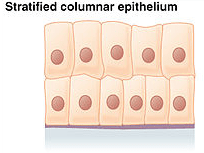Table of Contents
A stratified columnar epithelium (plural: stratified columnar epithelia) is a type of stratified epithelium in which the topmost layer is made up of columnar epithelial cells. Examples are those found in the conjunctiva of the eye, lobar ducts, certain parts of the male urethra, vas deferens, the uterus, anus, and the pharynx.
Etymology
The term stratified is from stratify, which, in particular, came from Latin strātificāre. The word columnar describes the structure to have a shape that resembles a column. The term epithelium came from New Latin epithēlium, which in turn came from the Ancient Greek ἐπί (epí), meaning “on” or “atop” and θηλή (thēlḗ), meaning “nipple”. Synonym: stratified columnar epithelial tissue.
Overview
A stratified epithelium is an epithelial tissue composed of more than one layer of epithelial cells. It differs from a simple epithelium in a way that the latter consists only one layer of epithelial cells. The basal layer of the stratified epithelium is the only one that is in contact with the basal lamina. The cells in the basal layer divide mitotically resulting in more cells atop the basal layer. The apical cells are regularly replaced by new cells produced through mitosis. The stratified epithelium may be further classified based on the type of cells located at the surface: squamous, columnar, or cuboidal.
Features and comparisons

In a stratified columnar epithelium, the epithelial cells are columnar in shape and arranged in two or more layers. This makes the stratified columnar epithelium different from the simple columnar type and the pseudostratified columnar epithelium. The latter two are comprised of only one layer of columnar epithelial cells. Furthermore, some simple columnar and pseudostratified columnar epithelial cells are ciliated. The three types, though, are similar in their cell shape and fundamental function.
| Stratified columnar epithelium | Pseudostratified epithelium | Simple columnar epithelium |
|---|---|---|
| Made up of two or more layers of columnar epithelial cells | Made up of one layer of columnar epithelial cells although it appears to have more than one layer due to the placing of the nuclei of the cells | Made up of one layer of columnar epithelial cells |
| Epithelial cells are taller than they are wide | Epithelial cells are taller than they are wide; some may have cilla | Epithelial cells are taller than they are wide; some may have cilla |
Locations:
| Locations:
| Locations:
|
Functions
The stratified columnar epithelium is involved primarily in providing protection and secretion.
Locations
The stratified columnar epithelial tissue is not as common as the other types of epithelium. It is found in the following body parts:
- Conjunctiva of the eye
- Lobar ducts of salivary glands
- Certain parts of the male urethra
- Vas deferens
- Uterus
- Anus
- Pharynx
See also
References
- Lutz Slomianka. (2019). Blue Histology – Epithelia and Glands. Retrieved from Uwa.edu.au website: http://www.lab.anhb.uwa.edu.au/mb140/CorePages/Epithelia/Epithel.htm
Further readings
- Anatomy Atlases: Atlas of Microscopic Anatomy: Section 1 – Cells. (2019). Retrieved from Anatomyatlases.org website: https://www.anatomyatlases.org/MicroscopicAnatomy/Section02/Plate0223.shtml
© Biology Online. Content provided and moderated by Biology Online Editors







